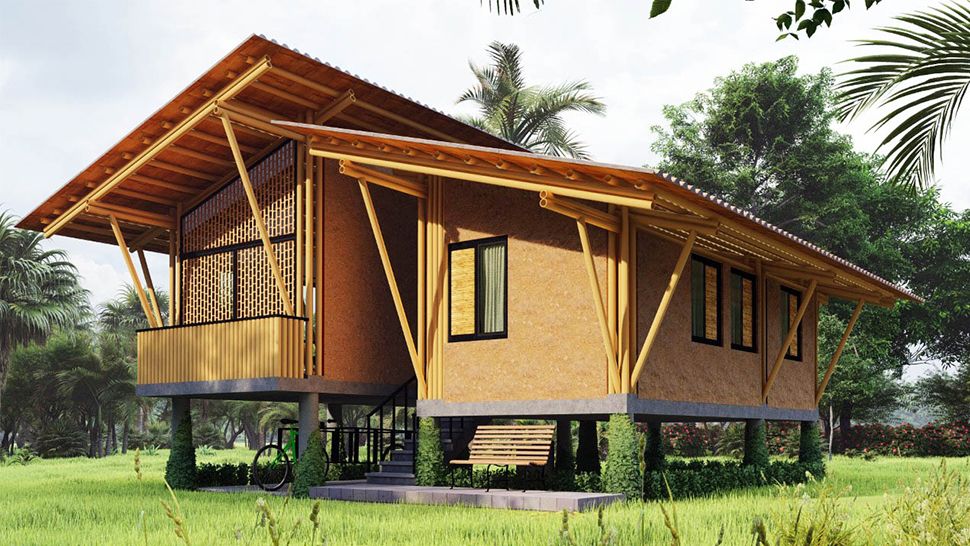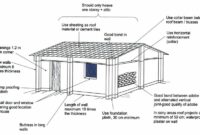Eco-Friendly Building Materials – As the world faces the consequences of climate change and environmental degradation, the demand for sustainable practices has reached the construction industry.
Home construction, once dominated by materials that consume large amounts of energy and resources, is undergoing a revolution with eco-friendly materials.
These materials not only minimize the environmental impact but also enhance energy efficiency, reduce waste, and improve indoor air quality.
Below are some of the most significant eco-friendly building materials that are transforming the future of home construction.
1. Bamboo: The Renewable Resource
Bamboo is one of the fastest-growing plants on Earth, making it an ideal sustainable building material. Unlike traditional wood, which can take decades to mature, bamboo can grow several feet in a single day. Its rapid growth and ability to regenerate without the need for replanting make it an excellent alternative to hardwoods.
- Durability: Despite its lightweight structure, bamboo is remarkably strong, with a tensile strength comparable to steel.
- Carbon Sequestration: Bamboo absorbs carbon dioxide from the atmosphere and releases oxygen, making it a carbon-negative material.
- Applications: It is widely used for flooring, paneling, and even structural elements in homes, offering a unique aesthetic while reducing reliance on slow-growing timber.
Read also:
1. Building a Tornado-Resistant Home: Key Strategies for Safety and Durability
2. Building Landslide-Resistant Homes: Key Strategies for Stability and Safety
3. Comprehensive Guide to Flood-Resistant Houses: Cause and Effect Analysis
2. Recycled Steel: Reducing Mining and Waste
Steel has long been a primary material in construction due to its strength and durability. However, producing new steel requires significant energy and natural resources, such as iron ore. Recycled steel offers a more sustainable alternative.
- Waste Reduction: Recycling steel reduces the need for mining and significantly lowers the amount of waste sent to landfills.
- Energy Efficiency: Producing steel from recycled materials consumes significantly less energy—up to 75% less—than creating new steel from raw ore.
- Applications: Recycled steel can be used in framing, roofing, and building infrastructure, ensuring long-lasting durability while minimizing environmental damage.
3. Hempcrete: A Natural Insulator
Hempcrete, made from the inner woody core of the hemp plant mixed with lime, is gaining popularity as a sustainable building material. It is biodegradable, lightweight, and provides excellent insulation.
- Thermal Performance: Hempcrete’s excellent thermal insulation properties help reduce energy consumption in homes by keeping interiors cooler in summer and warmer in winter.
- Carbon Absorption: The hemp plant absorbs CO2 as it grows, and the material continues to sequester carbon over time, contributing to its low carbon footprint.
- Applications: Hempcrete is used in walls, roofs, and floors, providing a breathable building material that helps regulate indoor air quality.
4. Reclaimed Wood: Preserving Forests
Reclaimed wood, sourced from old buildings, barns, or shipping pallets, reduces the need for new lumber. By repurposing this wood, builders can preserve forests and reduce the environmental impact of deforestation.
- Aesthetic Appeal: Reclaimed wood often comes with a rustic, unique character that enhances the design of a home.
- Energy and Resource Conservation: Reusing wood minimizes the energy required for manufacturing and processing new timber, reducing both resource consumption and emissions.
- Applications: Commonly used for flooring, beams, and furniture, reclaimed wood adds both beauty and sustainability to home designs.
5. Recycled Plastic: From Waste to Walls
Plastic waste has become a global environmental problem, but innovative builders are turning recycled plastics into valuable building materials. Recycled plastic can be used to create everything from insulation panels to composite lumber.
- Waste Management: Using recycled plastic in construction reduces the amount of plastic waste that ends up in landfills or oceans.
- Durability: Composite materials made from recycled plastics are resistant to moisture, pests, and decay, making them long-lasting and low-maintenance.
- Applications: Recycled plastic is used in fencing, outdoor decking, and insulation, offering versatile and eco-friendly options for modern homes.
6. Rammed Earth: Ancient Sustainability
Rammed earth is a traditional building method that uses natural raw materials such as soil, clay, and sand. It has been used for thousands of years and is experiencing a resurgence due to its sustainability.
- Energy Efficiency: Rammed earth walls have high thermal mass, meaning they store heat during the day and release it at night, reducing the need for artificial heating and cooling.
- Natural Materials: The process of building with rammed earth involves minimal processing, reducing the embodied energy of the construction.
- Applications: Rammed earth is commonly used in walls and foundations, providing both structural integrity and natural aesthetics.
7. Cork: Renewable and Versatile
Cork, harvested from the bark of cork oak trees, is a highly renewable resource that can be used in various aspects of construction. The harvesting process doesn’t harm the trees, and the bark regenerates, making it a sustainable choice.
- Insulation Properties: Cork is a natural insulator, providing excellent soundproofing and thermal insulation for homes.
- Fire Resistance: Cork is naturally fire-resistant, adding an extra layer of safety to buildings.
- Applications: Cork is commonly used in flooring, wall panels, and insulation, contributing to both energy efficiency and design flexibility.
8. Straw Bales: An Unexpected Solution
Straw bales, often a byproduct of agricultural practices, can be repurposed as an insulation material in home construction. They offer a highly sustainable and renewable option for eco-conscious builders.
- Thermal Insulation: Straw bales provide exceptional thermal insulation, helping to reduce heating and cooling costs.
- Affordability: Straw is widely available and inexpensive, making it an accessible material for sustainable building projects.
- Applications: Straw bales are used primarily in wall systems, where they are tightly packed and covered with plaster or other finishes, creating an energy-efficient and eco-friendly structure.
9. Green Roofs: Nature on Top
A green roof is more than just an aesthetic addition to a home. It involves planting vegetation on top of a building, providing numerous environmental benefits.
- Energy Efficiency: Green roofs act as natural insulators, reducing heat absorption and lowering energy costs for air conditioning.
- Stormwater Management: Green roofs help absorb rainwater, reducing runoff and easing the strain on urban drainage systems.
- Biodiversity: They provide habitats for birds and insects, supporting local ecosystems in urban environments.
- Applications: Green roofs are commonly found in urban areas, where space is limited but the need for environmental improvements is high.
10. Solar Tiles: Energy from the Sun
While solar panels have become a common sight on modern homes, solar tiles are taking things to the next level by integrating solar technology directly into the roof structure.
- Energy Generation: Solar tiles generate electricity by harnessing sunlight, reducing a home’s reliance on traditional energy sources.
- Aesthetic Integration: Unlike bulky solar panels, solar tiles blend seamlessly with a home’s roof, preserving the aesthetic appeal while providing energy savings.
- Durability: These tiles are designed to be durable and weather-resistant, ensuring long-term functionality.
- Applications: Solar tiles are primarily used in roofing systems, providing a dual purpose of energy production and protection from the elements.
Conclusion
The construction industry is embracing eco-friendly building materials to create homes that are not only sustainable but also energy-efficient, durable, and beautiful.
By incorporating materials like bamboo, recycled steel, and hempcrete, builders can reduce the environmental footprint of new homes.
As more homeowners and developers recognize the value of green construction, these innovative materials will continue to shape the future of home building, offering a path toward more sustainable living.
These eco-friendly materials are a testament to the power of innovation in the quest for sustainability, and their use marks a significant step toward reducing the impact of construction on our planet.






